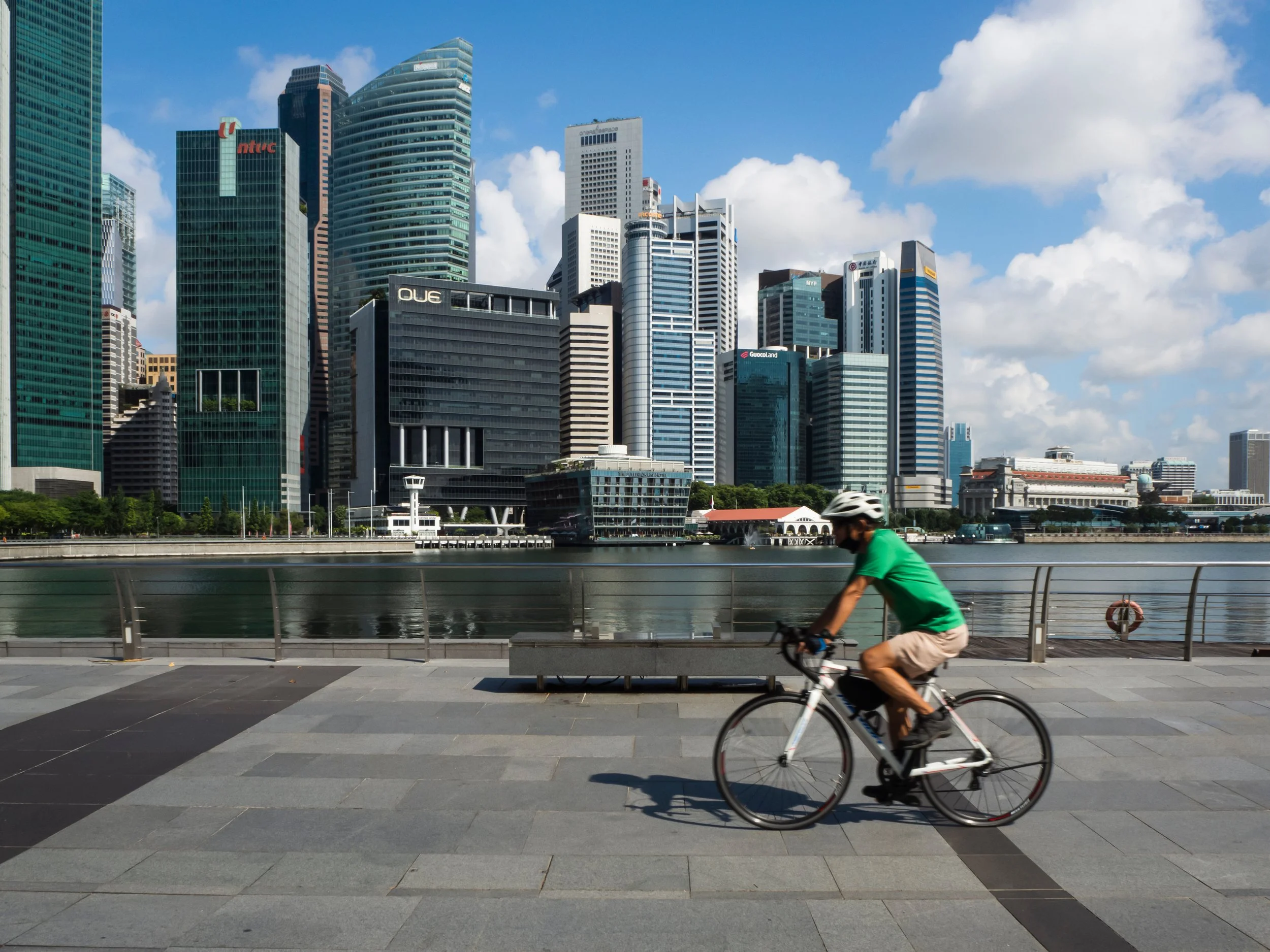International Cycling Law: Singapore
By Tushar Pal Nair
Singapore is a unique, vibrant and highly developed city-state located in South-East Asia, renowned for its weather, rich cuisine and industry. Singapore has a robust public transportation system that in recent years has incorporated cycling—due to its growth in popularity, several government initiatives, and interest from citizens. As cycling continues to grow in popularity in Singapore, the city has invested many resources into becoming a more cycling-friendly nation.
Population: 5,943,546
Ridership: Cycling comprises 2% of daily commuter trips in Singapore
Laws and Policies
Several agencies are responsible for regulating cycling laws and policies within Singapore proper and the surrounding towns on the island. These include the Land Transport Authority (LTA), the Urban Redevelopment Authority (URA) and NParks, the National Parks Board. Singapore has developed several policies and campaigns to improve cycling culture, including the National Cycling Plan and the #ExploreSG social media initiative. These govern the growth of cycling infrastructure around the island, and a tourism initiative to incorporate cycling with visiting historical landmarks, respectively. The Road Traffic Act legislation governs the laws regarding cycling. These laws include:
Section 7, paragraph 6 under chapter 276, section 140 states that if a cycling lane is provided, other lanes are not to be used by those using a bicycle.
Section 5 states that cyclists must signal while turning.
Bicycles must be fitted with a white light on the front and a red reflector on the back.
Cyclists must ride on the left side of the road.
Cycles must have fitted and working brakes.
Five to ten cyclists are allowed in groups on roads with two or more lanes, at most five in a single lane.
Singapore, Jan.3, 2022. Two well-attired cyclists along Yio Chu Kang Road. Cycling along the roads is a very popular recreation among local residents. Photo by Dr. David Sing (Shutterstock)
What makes this city’s cycling culture unique?
Part of what makes Singapore’s cycling culture unique is Singapore itself. Singapore is a large, global city-state that attracts tourists, workers and immigrants from across the world. Singapore has a high level of law and order, with strict rules governing driving etiquette and maintenance of infrastructure. As of 2020, there were over 440km of cycling paths connecting residential areas, scenic views, rivers and parks. Paths built in urban areas serve to connect residents to local amenities and public transportation. Singapore has a commuting culture that has been supplemented in recent years with cycling. There are currently plans in place to increase the cycling paths to 750km by 2025 and 1300km by 2030. Singapore has a culture of participating in a wide variety of outdoor activities year-round, with an increased interest in cycling in recent years. Although Singapore’s cycling culture is unique, the policymakers take extensive inspiration from Amsterdam and other Dutch cities.
What can be done to improve the city’s cycling culture?
Several issues serve as roadblocks to improving the cycling culture in Singapore. Due to being a tropical country, Singapore is afflicted by hot and humid weather for most of the year, including the monsoon season, which hampers cycling. Additionally, some citizens do not approve of cyclists, with 80% of drivers stating that there are more problematic cyclists on the roads than before. To solve these problems, initiatives to increase infrastructure by expanding cycling lanes and building sheltered cycling paths to protect from rainfall will serve to ensure that cyclists are able to ride in inclement conditions. The existing Confidence on Wheels program that teaches cycling and cycling rules can be expanded and improved upon. The Walking Cycling Riding Plan should also be extended and expanded to allow citizens to carry foldable bicycles onto public transit allowing for easier commuting and multiple modes of transportation.
Singapore, Aug. 13, 2021. Man cycling in the city near the Singapore River. Photo by helloitsme_sr (Shutterstock)
How does Singapore compare to London, Ontario?
Singapore is a far larger city than London, with several key differences. There are 1.2 million cyclists in all of Ontario, while the ridership in Singapore is two percent of the population (or roughly 1.2 million). London has over 350km of paths compared to Singapore’s 440km, with plans to rapidly expand to over 1300km by 2030. Singapore — like London — has a growing cycling culture with many outdoor activities year-round. Both Singapore and London suffer from inclement weather that impedes cycling for part of the year. These include monsoons in Singapore and winter in London. Singapore’s rules and regulations are currently more extensive and strictly enforced than London’s. This includes strict rules related to safety and driving etiquette. Singapore’s cycling infrastructure revolves around connecting riders to various amenities and locations. This and the other policy programs employed by Singapore can be used as a basis for policy programs in London related to cycling.
Works Consulted
Chng, Samuel. Commentary: We Need More than Bike Lanes for Cycling to Gear up in Singapore, CNA, 1 Jan. 2022, https://www.channelnewsasia.com/commentary/singapore-cycling-bicycle-lane-footpath-road-transport-rule-accident-lta-2387136.
“Cycling.” LTA, Land Transport Authority, 9 Apr. 2021, https://www.lta.gov.sg/content/ltagov/en/getting_around/active_mobility/walking_cycling_infrastructure/cycling.html.
Lee, Qian Yun, and Dorina Pojani. “Making Cycling Irresistible in Tropical Climates? Views from Singapore.” Policy Design and Practice, vol. 2, no. 4, 2019, pp. 359–369., https://doi.org/10.1080/25741292.2019.1665857.
Lim, Clayton Hon Choon, et al. “Singapore's Cycling Plan.” TRID, Transportation Research Board, 30 Nov. 2014, https://trid.trb.org/view/1538625.
“Road Traffic (Bicycles) Rules - Singapore Statutes ... - AGC.” Road Traffic (Bicycle) Rules, Road Traffic Act, 1 Feb. 2019, https://sso.agc.gov.sg/SL/RTA1961-R3.
“Rules & Code of Conduct.” LTA, Land Transport Authority 30 Mar. 2022, https://www.lta.gov.sg/content/ltagov/en/getting_around/active_mobility/rules_and_public_education/rules_and_code_of_conduct.html.
Rusterholtz, Author Alexander Erath. “Bicycle Infrastructure in Singapore: An Overview.” Engaging Mobility, Future Cities Laboratory, 5 May 2016, https://blogs.ethz.ch/engagingmobility/2016/05/03/bicycle-infrastructure-in-singapore-an-overview/.
Tham, Chen Munn. “Bicycle Infrastructure in Singapore: Will More Bicycle Paths Encourage More People to Cycle?” Urban Cycling Institute, Urban Cycling Institute, 11 July 2020, https://urbancyclinginstitute.com/bicycle-infrastructure-in-singapore-will-more-bicycle-paths-encourage-more-people-to-cycle/.


